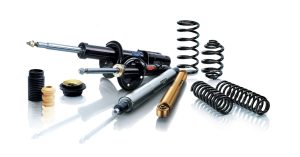A shock absorber might look simple from the outside, but beneath its housing lies an intricate system of components designed to tame suspension motion, damp vibrations, and enhance vehicle control. In this article, we’ll delve into the key parts inside a shock absorber, explain their functions, illustrate how they work together, and help you make informed decisions when shopping for replacements.
Shock Absorber Overview

A modern shock absorber — whether hydraulic or gas-charged — typically consists of:
-
Outer housing (tube)
-
Piston rod
-
Piston valve assembly
-
Inner and outer tubes (monotube or twin‑tube design)
-
Hydraulic oil and/or nitrogen gas
-
Reservoir chamber (in twin‑tube designs)
-
Seals, bushings, and mounting parts
Together, these components control how quickly the suspension compresses and rebounds — ensuring stable, predictable handling and ride comfort.
Main Components & Their Functions
| Component | Function |
|---|---|
| Outer Tube (Shell) | Houses all internal parts and mounts to suspension |
| Piston Rod | Connects piston to chassis, transmits damping force |
| Piston Valve | Controls fluid flow, determines damping rates |
| Inner/Working Tube | Contains oil and piston, in both designs |
| Outer Reservoir Tube | Stores displaced oil in twin‑tube shocks |
| Oil / Hydraulic Fluid | Provides resistance and lubrication |
| Nitrogen Gas (if present) | Prevents oil foaming, enhances response |
| Seals & Bushings | Prevent fluid leaks and reduce noise |
| Mounts / Eyelets | Connect shock absorber to vehicle structurally |
Outer Tube and Mounts
-
Outer tube: Steel cylinder encapsulating internal parts, usually sealed at the bottom.
-
Mounting components: Rubber or polyurethane bushings and metal eyes or studs — anchor the shock to vehicle arms or frame.
Piston Rod & Piston Valve
-
Piston rod: A polished steel shaft that slides through a seal at the top of the tube.
-
Piston valve: A metal shuttle with precisely calibrated holes and shims that meters oil flow, creating resistance during compression and rebound.
Working vs. Reservoir Tubes
-
Twin‑tube shocks: Feature an inner working tube and outer reservoir tube; fluid moves between the two during operation.
-
Monotube shocks: Use a single tube with a floating piston separating oil and nitrogen; superior heat dissipation and quicker response.
Oil and Gas Charge
-
Hydraulic oil: A specialized, high-temperature-resistant fluid that cushions and lubricates.
-
Nitrogen gas: Typically pressurized to 8–12 bar, nitrogen reduces aeration in the oil — critical for consistent performance under demanding conditions.
Seals and Bushings
-
Rod seal: Keeps oil from leaking along the piston rod.
-
Wiper seal: Removes dust/debris from the rod before it enters the tube.
-
End bushings: Dampen vibrations between the shock and vehicle chassis.
Compression and Rebound Mechanics
Shock absorbers control two main operations:
-
Compression stroke – Suspension moves upward; oil must flow through compression valves.
-
Rebound stroke – Suspension extends; oil flows through rebound valves.
Valves are often shimmed and tuned to achieve a balance between comfort and handling. High-end shocks provide separate compression/rebound tuning or even adaptive electronic control.
Twin-Tube vs. Monotube Design
| Feature | Twin-Tube | Monotube |
|---|---|---|
| Fluid flow | Between inner / outer tubes | Oil moves past floating piston |
| Heat dissipation | Moderate | Excellent |
| Orientation flexibility | Limited (must remain upright) | Any orientation |
| Manufacturing cost | Lower | Higher |
| Performance application | Daily driving, mild loads | Sports, off-road, heavy duty |
Shock Absorber Auxiliary Features
-
Adjustable damping: knobs for rebound/compression adjustability.
-
Reservoir types: internal (remote) or external; larger reservoirs help reduce heat-induced fading.
-
Enter competitive or luxury systems: active or magnetic dampers manage ride characteristics dynamically in milliseconds.
Common Wear Points and Failure Modes
-
Oil leaks: usually from rod seal failure — can lead to reduced damping.
-
Damaged rod surface: allows seal wear and fluid leaks.
-
Foamed oil: due to cavitation or gas ingress — results in spongy ride.
-
Internal wear: degraded valving leads to inconsistent damping.
-
Mount wear: worn bushings cause noise, excessive movement, and noise.
Signs It’s Time to Replace Shock Absorbers
-
Excessive bouncing after hitting a bump
-
Nose-dive during braking or rear squat during acceleration
-
Uneven tire wear or handling drift
-
Noticeable oil leakage on shock surface
-
Driving mode flash or ABS/ESC system instability
Installation Best Practices
-
Replace shocks in pairs (front or rear) to maintain balance
-
Torque mounting bolts per manufacturer specs
-
Use anti-seize on threads where specified
-
Cycle suspension post-install and re-torque
-
Dispose of old shocks properly — they contain fluid and gas under pressure
Where to Buy Replacement Shocks

When ready to replace worn-out shocks, choose quality-assured products designed for your vehicle’s demands and driving style:
buy Shock Absorbers online — explore hydraulic, gas-charged, adjustable, monotube, and reservoir-equipped shocks with fast shipping and trusted compatibility.
Final Thoughts
A shock absorber’s performance and longevity hinge on its internal components — tubes, piston valves, fluid, gas, and sealing systems — working in perfect harmony. Whether maintaining a daily commuter or upgrading for spirited driving, understanding its internal anatomy empowers you to choose the right replacement. Regular inspection, proper maintenance, and timely replacement of worn parts keep your suspension responsive, comfortable, and safe mile after mile.